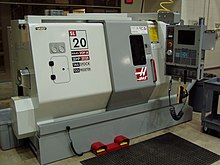Numerical control
Numerical Control (NC) is a way to automate machines. In numerical control, the commands these machines get come from a storage medium; they are not controlled and operated manually. The first such machines were Jacquard looms controlled by punched cards. Machine tools for cutting metal were built in the 1940s and 1950s. They used punched tape instructions. Soon, the tools were changed, to use computers. Numerical control with computers is known as Computer Numerical Control, or CNC.[1]


Nowadays, it is possible to make a program that can run on such machine tools, based on a CAD drawing of the piece to be produced.
Attempts to automate machines in the 19th century, for example copying-lathes, used cams. These are basically wheels that change the position of notches to control a machine. The basic difference to modern NC is that these cams only automated one given task; modern NC and CNC machines can be programmed to a greater extent.
History of the NC
changeThe invention of numerical control has been due to the pioneering works of John T. Parsons in the year 1940, when he tried to generate a curve automatically by milling cutters by providing coordinate motions. In the late 1940s Parsons conceived the method of using punched cards containing coordinate position system to control a machine tool. The machine directed to move in small increments and generate the desired finish. In 1948, Parsons demonstrated this concept to the US Air Force, who sponsored the series of project at laboratories of Massachusetts Institute of Technology (MIT). After research MIT was able to demonstrate first NC prototype in 1952 and in the next year they were able to prove the potential applications of the NC.[2]
CNC Milling Materials
changeOne of the most usual material types for milling are metals, and there are many to select from.[3][4]
- Aluminum - Perhaps the most widely used CNC milling material, for both mechanical and aspect components. Aluminum is generally able to be machined quicker than other metals, making it the most economically viable.
- Stainless Steel - Stainless steel alloys can be heat treated and supply corrosion resistant properties. Uses include surgical equipment, electronics hardware, and other parts that need formability and weldability.
- Titanium - What makes titanium unique is its high temperature melting point, making it useful for many industries and applications. It’s considered to be corrosion resistant, and impervious to ductile, salt, and water. Despite being biocompatible and lightweight, titanium material provides strength and sturdiness that makes it well-suited for applications like medical implants, aircraft components, and even jewelry.
References
change- ↑ "What are Numerical Control Machine? What are NC Machines?". www.brighthubengineering.com. 2009-11-12. Retrieved 2021-07-18.
- ↑ "What are Numerical Control Machine? What are NC Machines?". www.brighthubengineering.com. 2009-11-12. Retrieved 2021-07-18.
- ↑ Williams, Chris (2018-10-24). "CNC Materials: How To Choose The Right Materials for CNC Machining". Star Rapid. Retrieved 2021-07-18.
- ↑ "CNC Machining Material Selection Guide | American Micro Industries". www.americanmicroinc.com. Retrieved 2021-07-18.